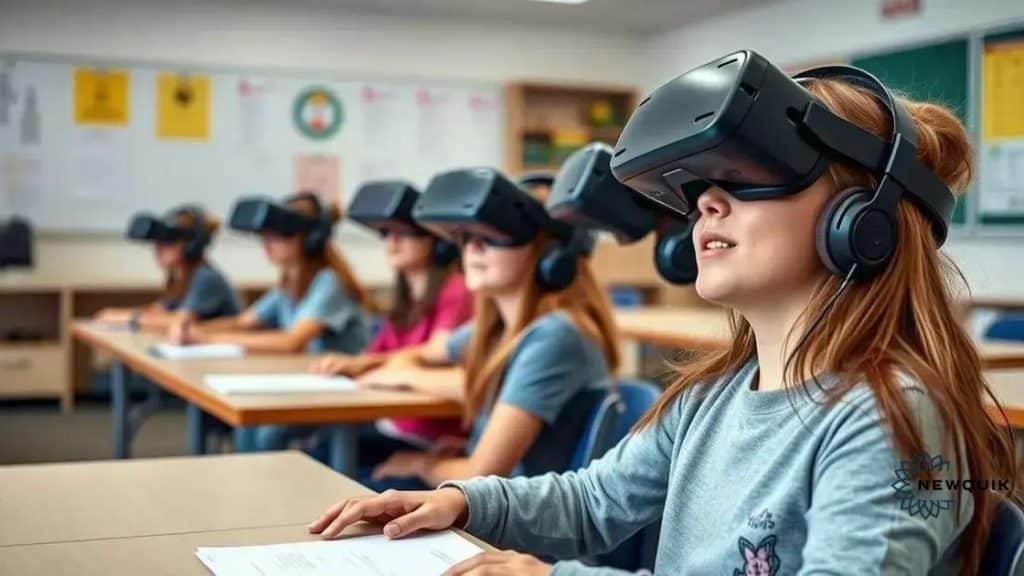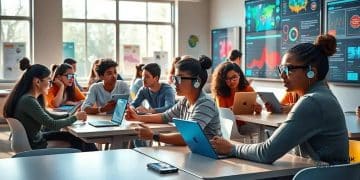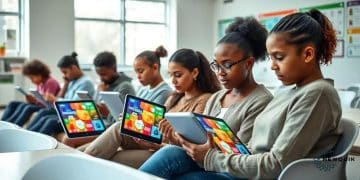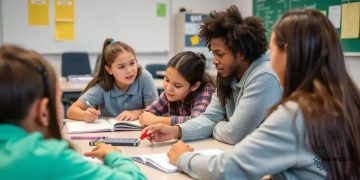Virtual reality classrooms: transforming remote learning

Anúncios
Virtual reality classrooms revolutionize education by providing immersive, engaging experiences that enhance learning through personalization, collaboration, and access to diverse resources, preparing students for a tech-driven future.
Virtual reality classrooms are reshaping the landscape of remote learning. Imagine stepping into a digital space where lessons come alive, fostering deeper engagement and understanding. Curious about how this technology can transform your learning experience?
Anúncios
Understanding virtual reality in education
Understanding virtual reality in education is essential for grasping how this technology can enhance the learning experience. By immersing students in a virtual world, concepts become more tangible and relatable. This approach fosters creativity and engagement, leading to better retention of information.
Virtual reality offers unique learning opportunities. Imagine studying history by virtually stepping into ancient civilizations or exploring the human body in a 3D environment. These scenarios can make lessons more memorable and exciting.
Key features of virtual reality in education
With the advancements in technology, the features of virtual reality are becoming more accessible for educational institutions. Here is what makes it stand out:
Anúncios
- Immersive experiences: Learners can engage fully with the material.
- Interactive learning: Students can participate actively, influencing outcomes.
- Safety in simulations: Allows for risk-free learning experiences in fields such as medicine or engineering.
- Collaboration: Students can work together in a virtual space, regardless of their physical location.
By incorporating virtual reality into curricula, educators can create a multi-sensory learning environment that caters to various learning styles. It’s not just about visual stimulation; it also involves auditory and kinesthetic elements, making the experience richer. This approach encourages students to explore and discover knowledge at their own pace.
Moreover, virtual reality can bridge gaps in accessibility. Students with different learning abilities can benefit from tailored experiences that address their individual needs. This technology has the potential to level the playing field, providing everyone with equal opportunities to learn effectively.
In summary, understanding virtual reality in education reveals how this cutting-edge technology can transform traditional learning methods. By making education more interactive, engaging, and personalized, we can prepare students for a future where they can thrive in a technology-driven world.
Benefits of virtual reality classrooms
Benefits of virtual reality classrooms are vast and impactful, fundamentally changing how students engage with content. These immersive environments not only make learning enjoyable but also promote a deeper understanding of complex subjects.
One major advantage of virtual reality classrooms is the enhancement of student engagement. Traditional learning methods can sometimes feel dull, but virtual reality brings lessons to life. Imagine studying biology, where students can virtually explore the human body. Such interactive experiences spark curiosity and enthusiasm in learners.
Key advantages to consider
When examining the benefits, the following points stand out:
- Improved retention: Hands-on experiences help students remember information longer.
- Accessibility: Students with different learning styles can find methods that suit them best.
- Safe simulation: Students can practice real-world skills without the risks involved.
- Global collaboration: Students can connect with peers from around the world in a shared virtual space.
Moreover, virtual reality classrooms create a unique opportunity for hands-on learning. In fields like engineering and medicine, students can practice skills in a safe environment, gaining confidence before facing real-world challenges. The immersive nature of these experiences often leads to greater motivation and a willingness to explore subjects further.
In addition, virtual reality supports personalized learning. Educators can tailor experiences to meet the individual needs of their students, ensuring that everyone can benefit from the instruction. This technological advancement encourages critical thinking and problem-solving in ways that traditional classrooms simply cannot.
As more schools adopt virtual reality, we can expect to see a shift in the educational landscape. Virtual reality classrooms offer innovative solutions to longstanding challenges in education, providing students with engaging, effective, and enjoyable ways to learn.
How to implement virtual reality in remote learning

Implementing virtual reality in remote learning can transform education for students and educators alike. It involves careful planning and consideration to ensure success. With the right approach, schools can harness the power of virtual reality to create engaging learning environments.
The first step to implement virtual reality is to assess the needs of both teachers and students. Consider what subjects would benefit from immersive experiences. For example, science classes might thrive with virtual lab simulations, while history classes could explore virtual tours of ancient civilizations. Tailoring the content to fit the curriculum is key for effective integration.
Choosing the right technology
Selecting the right virtual reality hardware and software is crucial for a successful implementation. Here are some tips:
- Research hardware options: Choose headsets that offer comfort and compatibility with educational software.
- Explore software solutions: Look for platforms that focus on educational content and provide user-friendly experiences.
- Consider budget: Make sure your choices fit within the school’s budget while still meeting educational goals.
Training teachers is also an essential part of the implementation process. Educators should feel comfortable using the technology, which can lead to more effective teaching. Provide training sessions that cover basic operations, lesson integration, and troubleshooting common issues. When teachers are prepared, they can create meaningful experiences for their students.
Once the necessary tools and training are in place, it’s time to start creating lessons. Collaborate with educators to design virtual reality lessons that align with learning objectives. Incorporation of virtual reality should enhance understanding rather than replace traditional methods. Use this technology to complement what students already know and extend their learning possibilities.
Finally, gather feedback from both teachers and students after implementation. It is important to see how effective the virtual reality experiences have been. Use this information to make necessary adjustments to improve future lessons. Continuous improvement ensures that the technology meets educational needs and maximizes learning outcomes.
Comparing traditional vs virtual classrooms
Comparing traditional classrooms with virtual classrooms reveals significant differences in how students learn and engage with material. While both settings aim to educate, the methods and experiences can vary greatly.
In traditional classrooms, students typically learn in physical environments with face-to-face interactions. This setup allows for direct communication between teachers and students, fostering relationships and immediate feedback. However, it may also come with limitations, such as geographical constraints or resource availability. Students in remote areas might struggle to access quality education, making it hard for them to thrive.
Benefits of virtual classrooms
On the other hand, virtual classrooms offer unique advantages:
- Flexibility: Students can learn at their own pace and choose their learning environment.
- Accessibility: Lessons can reach a broader audience, regardless of location.
- Diverse resources: Virtual classrooms often utilize multimedia tools, enhancing engagement through videos, simulations, and interactive activities.
- Custom learning experiences: Educators can tailor lessons to meet individual student needs effectively.
This flexibility allows students to balance their studies with other commitments, which can lead to more efficient learning. Virtual classrooms also incorporate various digital tools that can help make lessons more engaging and relevant.
However, traditional classrooms have their own strengths. They provide social interactions that foster teamwork and help build communication skills. Students can engage in hands-on activities that may be challenging to replicate in a virtual environment. The collaborative nature of traditional classrooms often leads to a sense of community.
Despite the benefits, traditional setups can feel rigid and may not fit all students’ learning styles. Virtual classrooms, in contrast, cater to diverse needs, allowing for personalized approaches to education. This adaptability can significantly impact student outcomes, giving them the chance to excel in ways they might not in a conventional classroom.
Future trends in virtual reality education
Future trends in virtual reality education promise to reshape how students learn and interact with information. As technology advances, new opportunities will emerge, enhancing the educational experience for learners around the world.
One key trend is the increased integration of artificial intelligence with virtual reality. This combination can create personalized learning environments that adapt to individual student needs. For instance, virtual reality platforms may analyze a student’s strengths and weaknesses, offering tailored content that helps them progress at their own pace.
Collaborative learning environments
Another exciting trend is the development of collaborative virtual classrooms. These spaces allow students from different locations to work together in real-time, sharing ideas and solving problems collectively. This interconnectedness fosters teamwork and global perspectives, preparing students for a diverse world.
- Social interaction: Students can communicate freely, mimicking real-world collaboration.
- Global reach: Virtual classrooms can include participants from anywhere in the world.
- Peer feedback: Engaging with peers can lead to more thoughtful and critical discussions.
Additionally, as technology becomes more affordable, more schools will adopt virtual reality tools, making this learning method accessible to a wider audience. Increased availability of headsets and software will encourage educators to explore innovative teaching strategies.
Moreover, the inclusion of gamification in virtual reality education is expected to grow. This trend integrates game-like elements into learning experiences, making lessons more engaging and motivating for students. By transforming education into an interactive experience, students can develop essential skills while having fun.
Finally, advancements in virtual reality content creation will likely lead to a surge in high-quality educational resources. Educators will have access to more immersive scenarios that can illustrate complex concepts clearly and engagingly. As these resources expand, they will allow teachers to foster deeper understanding and retention among their students.
Conclusion: The evolution of virtual reality education opens exciting doors for students and teachers. As we explore new trends, the focus will be on personalized learning, collaboration, and engagement. With the right tools and strategies, virtual reality can create immersive experiences that enhance understanding and retention. Embracing these innovations will prepare students for a future rich in possibilities, making learning more dynamic and enjoyable.
FAQ – Frequently Asked Questions about Virtual Reality in Education
What are the main benefits of using virtual reality in education?
Virtual reality enhances engagement, offers immersive learning experiences, and allows personalized education tailored to individual student needs.
How can virtual reality facilitate collaboration among students?
Virtual reality classrooms enable students from various locations to work together in real-time, fostering teamwork and global perspectives.
What tools are necessary for implementing virtual reality in schools?
Essential tools include VR headsets, educational software, and a reliable internet connection to support immersive experiences.
How does virtual reality help in developing critical skills?
Virtual reality provides interactive and practical scenarios that enhance problem-solving, critical thinking, and teamwork skills among students.





